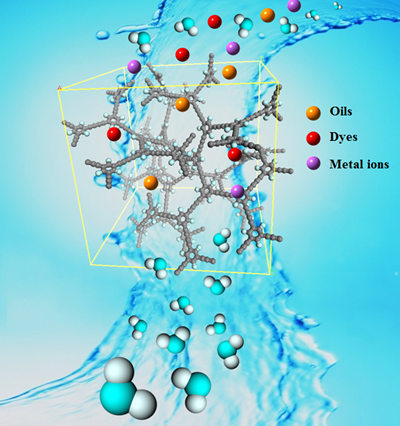Recently, Prof. Deng’s group made a progress in water treatment, using new synthesized perfluorous conjugated microporous polymer as an adsorbent. This work was published in Scientific reports 2015, 5, 10155, titled as “Extraordinary Capability for Water Treatment Achieved by a Perfluorous Conjugated Microporous Polymer”.
More than one-third of the human population remains without access or with only limited access to sanitary and safe drinking water despite major efforts to develop effective, economical, and robust methods for water purification. Oils, organic solvents, dyes, and heavy metal ions are primary pollutants in water resources. However, no sorbent material can effectively remove these types of pollutants simultaneously.

In this work, Prof. Deng reported a perfluorous conjugated microporous polymer with superhydrophobicity and a large surface area, which exhibits outstanding adsorption capacities, kinetics, and recyclability for a wide range of organic solvents, oils, dyes, and heavy metal ions. The adsorption capacities of this polymer, 1376.7 mg g-1 for Congo red, 808.2 mg g-1 for Pb(II) and 303.2 mg g-1 for As(V), are higher than the adsorption capacities of any previously described porous materials. The theoretical calculation revealed that the superior properties of this polymer are due to fluorination and triple bonds within the polymer. A benchmark experiment indicated that this polymer can efficiently remove these pollutants simultaneously. Application of this polymer may lead to the development of next-generation reusable and portable water purification appliances.
Since 2009, Prof. Deng’s group has been developing new conjugated microporous polymers and their applications, for example, hydrogen storage (Angew. Chemie.Int. Ed. 2010, 49, 3330), separation of oil from water (Energy Env.Sci. 2011, 4, 2062), and CO2 conversion and capture(Nature Commun. 2013, 4, 1960). This work was supported by NSFC 21373202, NSFC 21173209, and NSFC 91333116. (byRuixia Yang)